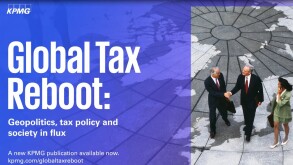The first edition of this two-part series, ESG tax transparency: The global journey, discussed how the public, business and government attitude to environmental, social and governance (ESG) tax matters has evolved and some views on the direction of travel of the tax transparency voluntary and mandatory reporting landscape. That is to say that more tax transparency is being requested and it is expected that more will be required as time goes on.
Reporting beyond requirements
For now, however, for most industries in most countries, the majority of tax transparency reporting is voluntary. This means that most businesses which are currently making disclosures, are reporting voluntarily, and there are many good reasons for doing so.
Telling your own story
There are many proponents of closing the gap between what companies are doing and what they are reporting. One group of such proponents are investors who are increasingly equating a business’s approach to tax a measure of value. Explaining ‘business as usual’ is not enough. Investors and stakeholders need the information to assess the value impact of the organisations tax strategy and tax governance policies which have been adopted from an economic, environmental and sustainability perspective. Tax transparency reporting can help organisations do this by providing a space to talk about how they operate with respect to tax in more detail, and with more real-life examples, than what may be contained in the business’s tax strategy or policy alone.
Where a business is reporting voluntarily, they are encouraged to attempt reporting in accordance with a recognised tax transparency standard, for example the Global Reporting Initiative’s (GRI’s) tax standard GRI 207, as this will likely stretch the organisation to evaluate current practices and encourage operational improvements. Even if the organisation cannot fully meet the reporting requirements immediately, critically assessing internal practices and making improvements as soon as possible should provide long term benefits.
Taking the opportunity, as a business, to explain the approach to tax taken and why the tax profile looks the way it does leaves less room for misinterpretation by those outside the organisation, for example, the media, non-governmental organisations (NGOs) and customers.
Tax and ESG ratings
Some multinational enterprises (MNEs) are interested to know the tax criteria that makes up a portion of their overall ESG ratings from rating agencies. However, this process can be frustrating for companies. Rating agencies take differing approaches to their ratings and often look to a different set of tax attributes to develop their ratings. This can lead to widely varying results between rating agencies for the same company. Studies have shown a correlation amongst rating agencies of only 0.46, showing significant disparity. Further, most rating agencies disclose only their high-level approach to tax without any detail as to specific inquires and how issues are weighted in developing the 'tax score' included in their ESG ratings.
These variations also complicate matters for investors, such as the more than 3,800 signatories of the UN’s Principles for Responsible Investors who wish to assess the responsible tax and ESG credentials of the companies they invest in. These discrepancies have led some investors to develop their own metrics and methodologies to integrate ESG considerations in their investment decisions.
Assessing your approach
Determining the right approach to tax transparency can be a complicated assessment. There is no commonly agreed upon standard as to what constitutes ‘good’ tax transparency reporting. For MNEs starting on their tax transparency journey, they will need to consider stakeholder expectations, relevant standards, regulators and the tax transparency disclosures of their peers. There will be requirements to comply with specific legislation and there will be decisions to be made about the level of (voluntary) conformity with standards.
Most companies will evaluate the actions of other businesses which are leaders in the field of tax transparency, reporting standards (e.g. GRI 207), relevant rating agencies’ ratings (e.g., S&P Global’s Sustainability Index), principle-based standards (e.g. Future Fit), business-led initiatives (e.g. B-Team principles; Word Economic Forum’s Stakeholder Capitalism Metrics), the expectations of NGOs (e.g. Fair Tax Mark); voluntary schemes (e.g. the Australian Tax Office (ATO) Tax Transparency Code; Extractive Industries Transparency Initiative); and existing regulations (e.g. EU’s Capital Requirements Directive IV and EU public country-by-country directive).
While all of these share some basic principles, details vary, and there currently is no indication of one standard approach. However, there is a clear trend towards increasingly detailed and recurrent reporting, covering both quantitative and qualitative aspects of MNE’s approach to tax. The focus is to present information that is understandable for the general public and informative and valuable to investors.
Public tax policy
The first step on the tax transparency journey is often a public group tax policy, or strategy (the terms after often used interchangeably). In its basic form, a public tax policy or strategy should list core tax principles, who approves the policy, and detail the company’s approach to tax matters and tax governance. Typically, this would include information on the company’s:
Tax governance arrangements (accountability for tax affairs and tax risks; responsibility for implementing the tax policy / strategy, review and testing of tax risk controls etc.);
Tax risk appetite and approach to tax risks;
Approach to tax planning, use of tax incentives, presence in tax havens;
Transfer pricing model; and
Relationship with tax authorities and other stakeholders.
It is important that the tax principles set out in the tax strategy or policy are actionable; that is, they should be clear and practical enough to be used by a company’s tax function and its external advisors to use as guidance, and for external stakeholders, including tax authorities, to be able to form clear expectations of a company’s approach to tax. To achieve this, it is important for companies to consider their tax policy or strategy as part of their wider corporate and sustainability strategies, and to strive to ensure that their tax strategy reflects their brand and the values they endorse and communicate to the public. The tax strategy should thus be another tool supporting the delivery of the company’s commitments to its stakeholders.
It is believed that, GRI 207 is the most agreed standard for what should be included in a tax strategy. The standard calls for disclosure of the company’s approach to tax (e.g., who approves the strategy and approach to tax compliance), tax governance and tax risk management (e.g., a description of the tax governance and control framework and how unethical behavior is dealt with), and stakeholder engagement (e.g., the approach to stakeholder engagement and public tax policy advocacy).
Quantitative disclosures
As an equally important, but practically very different disclosure, there are substantive quantitative disclosures, which mainly take two forms:
The total tax footprint: A company’s total taxes borne and collected, demonstrating their contribution to society. Often reported on a global basis by type of tax, but increasingly MNEs are observed reporting their total tax footprint by region and, in some cases, by country.
Country-by-country reporting: A disclosure of corporate income tax paid on a country-by-country basis, often accompanied by other figures (e.g. revenue per country, number of employees per country) to provide context.
In the past few years, an increasing number of MNEs, mostly based in Europe and Australia, have started disclosing data on their total tax footprint. For some MNEs this information is presented as a single paragraph in their annual financial or sustainability report, while others include significant detail in separate tax or economic contribution reports, describing their tax payments across all active jurisdictions and emphasising their tax commitments and describing how their tax governance arrangements work in practice.
Practical considerations
Important considerations in determining tax transparency are the cost and the effort to produce reliable data. As all MNEs who have had to prepare government country-by-country reporting (CbCR) filings have learned, the extraction and aggregation of tax data, and aiming to ensure the completeness, accuracy, and consistency of the data, have been significant undertakings. This is partially due to the fact that accounting and bookkeeping systems were not designed to collect and report tax data. Additionally, many groups use multiple enterprise resource planning (ERP) systems, complicating any centralised approach to gathering data.
Using CbCR data for public reporting will likely require additional investment in process and systems. To trust the tax data for public CbCR, companies should identify risks and weaknesses in their current systems, implement strong data governance measures, and develop guidelines for how to book various tax payments to aid in gathering tax data afterward. More effort should be put in place to help ensure public CbCR information is reconciled with group-wide consolidated results and possibly even statutory accounts.
Additionally, some MNEs will likely consider an assurance process to validate the integrity of their tax data before using it in tax transparency reporting.
As companies assess their approach to tax transparency, it is important to realise that providing numbers in isolation can lead to misinterpretation and misrepresentation. The tax strategy narratives around strategy, policy, risk management, and governance are vitally important in providing a complete picture and comfort that the company’s approach to tax is sustainable.
What you should consider now
The tax function can significantly contribute to your company’s ESG journey. This requires an ongoing assessment of where you are on the tax ESG maturity curve and balancing sometimes competing stakeholder expectations. Key is striving to ensure your tax governance is fit for today’s business environment and having a clear policy toward tax transparency. KPMG firms have developed an ESG tax methodology and tools that can help illustrate what this journey looks like for business – KPMG Tax Impact Reporting.
Tax strategy
Under this methodology, companies should start with an evaluation of their core tax principles and then develop or refine their tax strategies to project these values. Your strategy statement can drive how your tax principles will be embedded throughout the business.
Maintaining the right tax strategy is an ongoing process driven by factors such as your company’s overall ESG commitments, where you currently are on the ESG tax maturity curve, and benchmarking against peers. These data points can help you make adjustments as needed. However, benchmarking against peers can be difficult as peer scores are not always available and the reasons for their scores are frequently opaque. Although companies could do their own benchmarking research, service providers often have tools that can assist. For example, the KPMG Impact Tax Assessment tool is a proprietary digital solution benchmarking ESG tax performance using publicly available information.
Tax governance
Once you’re comfortable and your tax strategy is up to date and fit for purpose, review your tax governance and control framework to help ensure it is aligned with your approach to tax as set out in your strategy document. Improvements in both governance and tax control framework may be needed. Most tax controls are focused on accurately reporting the past whereas ESG tax controls are focused on how decisions on tax positions are made.
Tax transparency
With a solid tax strategy and supporting governance and control framework, companies should be positioned to determine the degree of tax transparency that is right for them. This could be from reporting what is legally required, to full public CbCR. If a company decides to disclose their tax strategy, such a move typically doesn’t raise any real data or compliance concerns. However, a decision to report global taxes paid, by type, is a significant undertaking. Different types of taxes are often accessible only through different internal systems and can be buried within other cost descriptions. Finding these taxes, unbundling them from other cost centers, and reporting them can be a labor-intensive exercise that requires collaboration with business teams. This is further complicated if the company chooses to disclose these figures on a country-by-country basis. MNEs should expect to leverage technology solutions that can extract the needed data and automate the reporting process as much as possible. KPMG’s Tax Footprint Analyzer technologies are designed to provide companies this type of automation, along with data analytics that can provide insights and enhances your reporting.
Conclusion
Tax reporting limited to what is legally required under today’s regulatory regimes is already viewed as inadequate by much of the ESG community. Reporting on your global tax strategy is a good place to start. What makes sense beyond that is an informed decision assessing the various considerations described above and re-evaluated over time. Regardless of where you start with tax transparency, the direction of travel is clear, and organisations should expect disclosure requirements to increase.
Parts of this article were originally published in the professional journal of the Tax Executives Institute.



































